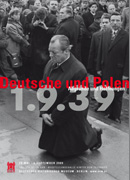


Exhibition | Oppression and Self-assertion | War and Occupation | Conflicts and Rapprochements
The Federal Republic of Germany and Poland Through 1989
| "Friendship" under the Socialist Order
Memories of the War and Polish Perception of Germany
| "A Difficult Episode"
The Soviet Union, espousing an ideology of a "socialist community of nations" in Eastern Europe, compelled the GDR and Poland to maintain a "forced friendship": conflicts between the two states were officially prohibited. East Germany viewed itself as an anti-Fascist state standing, along with Poland, on the "right" side of history. The issue of the expulsions taking place after 1945 was taboo, however, since it could have led to conflicts with the Soviet Union and Poland.
Poland was especially attractive to visitors from East Germany, since they were allowed to travel without a visa for a certain amount of time and since Poland was a more liberal and open society than their own. East Germany's opposition movement based itself on the Polish model, even disseminating literature from the Polish Solidarność union in its campaign against the East German regime. Several hundred East German citizens fled the country in 1989 by way of Poland, where they found support from the public authorities and from ordinary citizens sympathizing with their desire for freedom.
